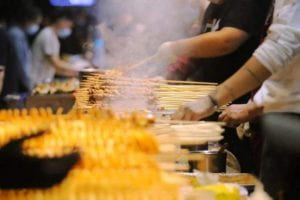The contradiction between street vending and urban modernization seems to be a long-term problem that every country cannot circumvent in the development process. Generally speaking, the hawkers are always denounced as hurting legitimate business, accused of encroaching on public land and dirtying the streets by the people. Bluestone traced the constant changes of policies regulating the pushcart markets in New York City, which are closely related to the social development and economic condition of America. According to Bluestone, various reform efforts to curb the pushcart markets was particularly acute during the Great Depression of 1930s, when pushcarts represented just “another uncomfortable reminder of the instability and failure of national economic life.” (pp. 75) And in Mumbai, mentioned by Rajagopal, “hawkers become a mirror for all kinds of doubts and ills attending the transition from state-led development to market liberalization” (pp. 227). Indeed, rise and fall of the stalls in different historical periods are just symptoms of the market force. The actions of hawkers are driven by corresponding policies of the government in specific economic environments. The reason why the Chinese government encouraged the public to develop the stall economy at the beginning of this year was to change the sluggish economic development under the influence of Covid-19, to promote employment and stimulate consumption – so the various problems caused by stalls in city management can be temporarily put aside. The development of the stall economy is a double-edged sword in today’s society, while acknowledging its effectiveness, we should also recognize the need to refine urban management for the government. (Read an article discussed this two-sided influence of stall economy in China)

A BBQ stall – A representative of street stalls in China
Here’s also a special characteristic of the hawkers in China. As Ray said, some people who have lost their jobs will choose to run a street stall as a transitional career until they find a formal one in the job market. Such “transitional” feature is especially common and prominent in street vending of China, but in a different sense. Influenced by the long-term cultural tradition of “An Tu Zhong Qian” (which means be attached to the living place and unwilling to leave it), Chinese people always long for buying their own houses and take root in the place of life, even paying a great price. Therefore, almost all the vendors have a final goal to purchase their own storefronts, carrying out regular and stable sales of goods. Depending on the business situation, this struggle process may take the stall owners from one year to several decades, or it may never be realized. During my undergraduate studies, as a regular customer, I became friends with a stall owner who sells Tanghulu near my university, then I learned that his family lives by street vending and his mother had been selling sugar-fried chestnuts in front of a nearby market for more than ten years. His business has been very good in the past two years, so his family quickly decided to buy a storefront near the entrance of the university. Obviously, the end of the mobile stall life is an important turning point for him and his family. He gained a sense of security and confidence, got married last year, and now begins to sell a variety kinds of food to expand their business.
Leave a Reply